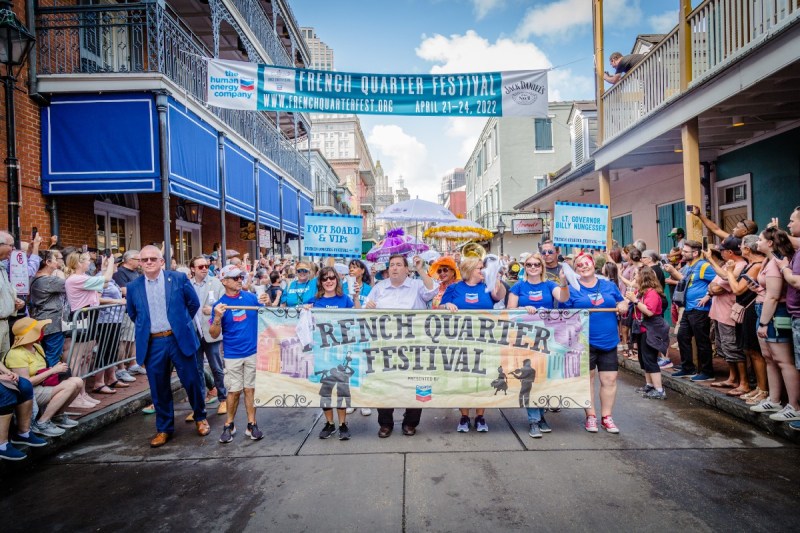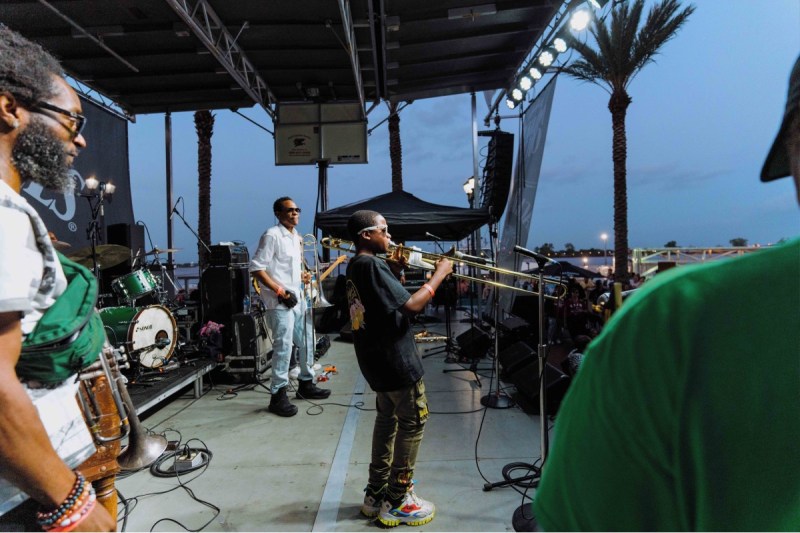Mardi Gras may be the most iconic New Orleans celebration, but the Big Easy’s largest celebration of local music actually lands after Easter each year. Over four sound-stuffed days and nights, the French Quarter Festival features 1,700 musicians playing 400 hours of free, local music on 25 stages.
Former Mayor Ernest Nathan Morial, looking to maintain momentum from the 1984 Louisiana World Exposition, founded the French Quarter Festival in 1984. The French Quarter Fest has been the place to immerse in the city’s incredible distinct culture shaped by a dynamic gumbo of African American, Cajun, Caribbean, Creole, French, Spanish, and additional influences. Almost four decades later, organizers not only continued the gathering’s tradition in 2022 (post-pandemic shutdown), but they are shaping a sustainable future and acting as a model for brethren fetes with the Geauxing Green program.

Presented by Chevron, and partnered and supported by the nearby Barataria Terrebonne National Estuary Program (BTNEP), eight spirited full-time French Quarter Fest, Inc. (FQFI) teammates and 200 temporary workers were able to increase overall waste diversion (away from landfills) by more than 25% in comparison to the 2019 festival.
During the fest, the Geauxing Green Initiative placed 130 reusable waste bins throughout all four major festival sites. By instituting composting, glass recycling, donations, and collaborative upcycling (and posting helping hands next to waste bins), efforts succeeded in creating 30,000 pounds of recycled waste, which was a 119% increase from 2019.
“We are working to be a leader in sustainable festival production in the South,” Andrew Woodruff, FQFI Director of Operations, said in a statement. “We hope that our program can be seen as a tool for education around the importance of marine debris prevention and make greater impacts on our local community and the Gulf South region.”
As the largest free festival and showcase of Louisiana music, food, and culture, the French Quarter Fest also creates tons of waste. According to the BBC, major U.S. festivals like Coachella, Stagecoach, and Desert Trip generate around 100 tons of solid waste every day, while an estimated 23,500 tons of waste are produced annually by U.K. music festivals. For the fragile Mississippi Delta, the surrounding rivers and bayous, and the mighty Gulf of Mexico below, this can be a problem.

In the Gulf South, estuaries, rivers, marshes, and bayous that cover hundreds of acres of land have already been drastically affected by human activity and settlement. This includes the improper disposal of waste from festivals — wristbands, fancy dress clothing, glitter, ponchos, toiletries, and more — all made from polymers that can persist in the environment for decades, if not centuries. In Louisiana, it’s estimated an acre of coastal wetlands (equivalent to the size of one football field) is lost every 100 minutes.
While these are staggering numbers, they tend to get short shrift when compared to more immediate considerations, namely profit margins for festival vendors who already lost two years of business to COVID-19 closures. The South is also not considered a forerunner in implementing green practices.
“It took a little finesse to get everyone to buy in,” said Kenneth Spears, the food and beverage director. “There are a lot of people on these waters, but it’s the first time these practices have been implemented during a festival of this size. Coming out of the pandemic, vendors were looking mostly at the bottom line. Our job was to understand the effort those guys are putting in and convince them to rise above.”
A combination of money and mentorship was what enabled the tiny festival management team to get Geauxing Green rolling in the first place.
Woodruff’s predecessor worked alongside the nonprofit BTNEP to apply for an EPA grant tied to festival sustainability and coastal protection in the Deep South. The estuary protection agency assisted FQFI directors to lay out specific sustainability goals. Then, the same day the grant was accepted, pandemic shutdowns took effect. The FQFI team took this blow in stride, using the extra time to flesh out Geauxing Green.
“That was our silver lining to the pandemic. We got canceled, but it allowed us to dig in,” Woodruff said. “We did a lot of work to determine what was possible, map out what would be the best return on the investment, and plan this so that sustainable outcomes outlast the grant (two years). We don’t want to introduce progress and then have funding dry up.”
Organizers were able to test this plan at the smaller Satchmo SummerFest in August 2021. This laid the blueprint for the much larger FQFI this spring. Subsequently, final numbers from both events will aid BTNEP in developing a “Sustainable Festival Planning Guide” for the Environmental Protection Agency’s Gulf of Mexico Division. Digital publication of the guide will offer guidelines and instructions to other communities free online.

“The hope is that not only do we educate the general public to make things greener here, but our vendors can go home, be greener, and tell other vendors how it helps their business in the end,” FQFI marketing and communications director Morgan Valerie said.
Though the South may not be considered a hub for progressive environmental efforts, the FQFI staff is excited to lead the way.
“It feels good to be part of the team setting the standard for sustainability here,” Spears said.
Valerie sees the possibility for Geauxing Green to spark united change.
“We‘re a community that comes together, but it takes education to make that next step. It takes folks to say, ‘I get it and I want to restore my city.’ The hope is that we can be a leader in our city, state, and region,” Valerie said.
Numbers from the initial launch are encouraging. Organizers diverted 36,000 pounds of compost to The Composting Network to make garden soil. Also, 29,500 pounds of plastic, aluminum, and paper were diverted from landfills and recycled with the help of Waste Connections. And 9,000 pounds of glass were collected and handed over to Glass Half Full to make sandbags for coastal storm defense. French Quarter Festival signage of 1,000 pounds will be repurposed for Mardi Gras floats, student projects, and reused for the 2023 festival.
Though Geauxing Green made quite an impact in its first go-round, the team will look to increase diversion percentages looking forward to more 2022 and 2023 events.



